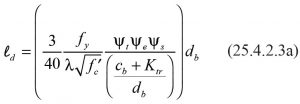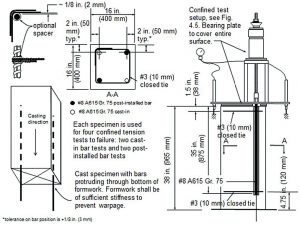Reinforcing Bar Development Length using the Provisions of ACI 318
A key aspect of reinforced concrete design is the calculation of the required reinforcing area and the required development and splice lengths for proper reinforcement details. In most structures, the reinforcement is cast with the concrete and subsequent concrete pours, i.e. “new” concrete, is placed around the cast-in-place reinforcement protruding from the existing concrete. The cast-in-place reinforcement’s development length is prescribed by ACI 318-14 Chapter 25, “Reinforcement Details,” or Section 25.4.2.3, (Chapter 12, Section 12.2.3, in previous versions of ACI). Engineers are familiar with the basic expression for tension development length in Ch. 25 from the following equation:
Unfortunately, reinforcement is not always cast into the existing concrete when a new section of concrete will be connected to existing concrete. Examples include renovations where the original building plan did not account for the new concrete section, strengthening a structure to improve the seismic performance, or rehabilitation of an existing structure.
When cast-in reinforcement is not provided in the existing concrete, a post-installed adhesive anchor system is commonly used to attach reinforcement to the existing concrete. Post-installed adhesive anchor systems have been around since the mid-1970s and are widely used in construction today for a variety of applications including attachment of threaded rods and reinforcement to concrete. Design of post-installed adhesive systems is regulated by ACI 318-14 Chapter 17, “Anchoring to Concrete.” (Note, the provisions of ACI 318-14, Chapter 17 are the same as the provisions of ACI 318-11, Appendix D.) However, Chapter 17 is intended for the design of both cast-in-place headed bolts and post-installed anchors to transfer tension and shear loads from a connected structural element, typically a steel fixture, to the concrete member and does not deal with reinforcement development lengths. Additionally, Chapter 17, Section 17.3.2.3 only permits designs for a maximum embedment of 20 times the anchor diameter, which can be less than the embedment depth calculated for development.
So how would an engineer design an application where attaching new concrete to an existing concrete structure is required when there are no cast-in-place bars to connect having proper development length?
To address this, ICC Evaluation Services updated the test criteria, Acceptance Criteria for Post-Installed Adhesive Anchors in Concrete Elements (AC308), in June 2013. The update includes adhesive anchor system qualification tests for use with the development length provisions of Chapter 25 and seismic requirements of ACI 318-14 Chapter 18, “Earthquake Resistant Structures.” Before 2013, AC308 only included tests for anchor designs applicable for ACI 318-11 Appendix D.

ICC-ES AC308 Figure 4.6 – test specimen to confirm bond and splitting behavior at deep embedment. Courtesy of 2016 ICC Evaluation Service, LLC.
In 2013, AC308 Table 3.8, “Test program for evaluating deformed reinforcing bars for use in post-installed reinforcing bar connections,” was added for manufacturers that wanted their adhesive system to be recognized for use with the reinforcement development provisions. Successful completion of the tests show that the adhesive anchor system will perform equally to a cast-in-place reinforcing bar, even with an embedment depth beyond the 20 anchor diameters maximum in Chapter 17. The testing is rigorous and is intended to prove the following:
- The adhesive anchor system has a stiffness that will transfer load over the full length of the reinforcement and a bond strength that is equal to the cast-in reinforcement tension strength.
- The adhesive anchor system can be installed at embedment depths beyond 20 times the bar diameter without the adhesive product hardening before the reinforcement is inserted, and the adhesive injection is free of voids.
To show equal performance and stiffness, the bond/splitting force test found in AC308 Table 3.8 requires two reinforcing bars to be cast in opposite corners of a concrete “column” and two post-installed adhesive anchors with reinforcing bars to be installed in the other corners. The embedment depth is 35 bar diameters. Each cast-in and post-installed reinforcing bar is tension tested independently. The mean ultimate tension load and displacement must be equivalent between the two systems. The test setup for the bond/splitting force test is shown in Figure 4.6 of AC308 (included in this article). This test checks the load transfer of the adhesive system over the entire length of the reinforcing bar.
To show that the adhesive anchor system can be installed properly at embedment depths beyond 20 bar diameters, AC308 Table 3.8 has two installation verification tests at an embedment depth of 60 bar diameters. The first test verifies that the reinforcing bar can be inserted to the full 60 bar diameter embedment before the adhesive system begins to gel (harden). All adhesive systems have product-specific working (gel) times and cure times. Adhesive anchors that can be installed at the 20 bar diameter embedment for anchor applications may not work at this extended length if the product has a fast gel time. The second test verifies that the adhesive system, when injected, leaves no voids in the drilled hole which would reduce the bond strength.
After successful completion of the AC308 Table 3.8 tests, the product can be recognized in a product-specific evaluation report from an independent product evaluation service such as ICC Evaluation Services. Evaluation reports should specifically mention testing is in accordance with AC308 Table 3.8. Engineers can now use Equation 25.4.2.3a from ACI 318 to design reinforcing development lengths for reinforcing bars whether cast-in or installed with a qualified post-installed adhesive system.
In summary, where cast-in reinforcing bars are not present in the existing concrete member, structural engineers can use the traditional ACI 318 reinforcing bar development lengths when a qualified post-installed adhesive system is used. The development length design will be the same regardless if the reinforcement is cast-in or post-installed. The selection of the proper adhesive can be authenticated with an independent evaluation report that verifies the product has successfully passed the difficult AC308 Table 3.8 test requirements.▪
